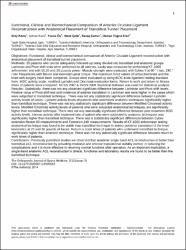| dc.contributor.author | Kılınç, Eray | |
| dc.contributor.author | Kara, Adnan | |
| dc.contributor.author | Öç, Yunus | |
| dc.contributor.author | Çelik, Haluk | |
| dc.contributor.author | Çamur, Savaş | |
| dc.contributor.author | Eren, Osman Tuǧrul | |
| dc.date.accessioned | 10.07.201910:49:13 | |
| dc.date.accessioned | 2019-07-10T19:37:17Z | |
| dc.date.available | 10.07.201910:49:14 | |
| dc.date.available | 2019-07-10T19:37:17Z | |
| dc.date.issued | 2014 | en_US |
| dc.identifier.citation | Kılınç, E., Kara, A., Öç, Y., Çelik, H., Çamur, S. ve Eren, O. T. (2014). Functional, clinical and biomechanical comparison of anterior cruciate ligament reconstruction with anatomical placement of transtibial tunnel placement. Orthopaedic Journal of Sports Medicine, 2(11). https://dx.doi.org/10.1177/2325967114S00152 | en_US |
| dc.identifier.issn | 2325-9671 | |
| dc.identifier.uri | https://dx.doi.org/10.1177/2325967114S00152 | |
| dc.identifier.uri | https://hdl.handle.net/20.500.12511/1370 | |
| dc.description.abstract | Objectives: Functional, clinical and biomechanical comparison of Anterior Cruciate Ligament reconstruction with anatomical placement of transtibial tunnel placement. Methods: 55 patients who can be adequately followed-up being divided into transtibial and anatomic groups. Lachman and Pivot-shift tests were performed to all patients. Laxity was measured by performing KT-1000 arthrometer test with 15,20 and 30 pounds power. Muscle strength were evaluated with Cybex II at 60 ° / sec, 240 ° / sec frequencies with flexion and extension peak torque. The maximum force values of untouched knee and the knee with surgery have been compared. Groups were evaluated by using IKDC knee ligament healing standard form, IKDC activity scale, modified Lysholm and Cincinnati evaluation forms. Return to work and return to fitness times of patients were compared. NCSS 2007 & PASS 2008 Statistical Software was used for statistical analysis. Results: Statistically, there was not any observed significant difference between Lachman and Pivot-shift levels. Positive value of Pivot-shift test and incidence of anterior translation in Lachman test were higher in the cases which were subjected to transtibial technique. There was not any statistically significant difference between Lysholm activity levels of cases. Lysholm activity levels of patients who underwent anatomic techniques significantly higher than transtibial technique. There was not any statistically significant difference between Modified Cincinnati activity levels. Modified Cincinnati activity levels of patients who were subjected anatomical techniques, are significantly higher than transtibial technique. There was not any statistically significant difference between post treatment IKDC activity levels. Intense activity after treatment rate of patient who were subjected to anatomic techniques was significantly higher than transtibial technique. There was a statistically significant differences between Cybex extension-flexion 60 measurements and Extension 240 measurements. Results of KT-1000 arthrometer testing anatomical technique was found to be stable than transtibial technique in antero-posterior translation of the knee kinematics at 20 and 30 pounds of forces. Return to sport times of patients who underwent transtibial technique, significantly higher than anatomic technique. There was not any statistically significant difference between return to work times of patients. Conclusion: Previously published studies we observed that anatomic single band ACL reconstruction is better than transtibial ACL reconstruction by providing rotational and anterior translational stability control, in reducing the complications and it is more effective in returning normal functions after operation. As an important implication, a single-band anatomic ACL reconstruction’s clinical, functional and laboratory results are found to be better than the transtibial technique. | en_US |
| dc.language.iso | eng | en_US |
| dc.publisher | SAGE Publications Ltd | en_US |
| dc.rights | info:eu-repo/semantics/openAccess | en_US |
| dc.rights | Attribution-NonCommercial-NoDerivs 3.0 Unported | * |
| dc.rights.uri | https://creativecommons.org/licenses/by-nc-nd/3.0/ | * |
| dc.subject | Transtibial | en_US |
| dc.subject | Anatomical | en_US |
| dc.subject | Anterior | en_US |
| dc.title | Functional, clinical and biomechanical comparison of anterior cruciate ligament reconstruction with anatomical placement of transtibial tunnel placement | en_US |
| dc.type | other | en_US |
| dc.relation.ispartof | Orthopaedic Journal of Sports Medicine | en_US |
| dc.department | İstanbul Medipol Üniversitesi, Tıp Fakültesi, Cerrahi Tıp Bilimleri Bölümü, Ortopedi ve Travmatoloji Ana Bilim Dalı | en_US |
| dc.identifier.volume | 2 | en_US |
| dc.identifier.issue | 11 | en_US |
| dc.relation.publicationcategory | Diğer | en_US |
| dc.identifier.doi | 10.1177/2325967114S00152 | en_US |
| dc.identifier.scopusquality | Q2 | en_US |



















